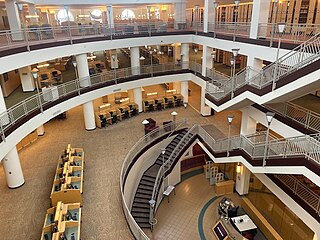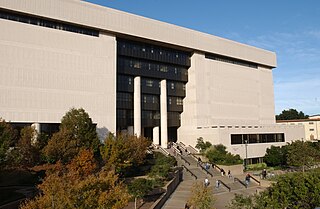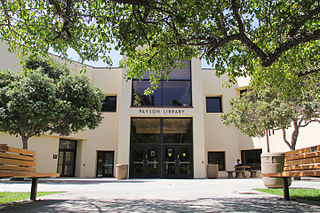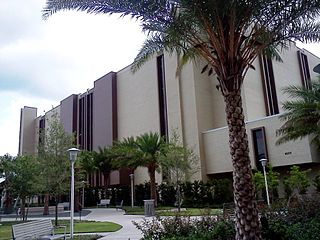
San Francisco State University is a public research university in San Francisco. It was established in 1899 as the San Francisco State Normal School and is part of the California State University system.

The University of Texas System is a public university system in the U.S. state of Texas. It includes nine universities and five independent health institutions. The UT System is headquartered in Downtown Austin. It is the largest university system in Texas with 250,000+ enrolled students, 21,000+ employed faculty, 83,000+ health care professionals, researchers and support staff. The UT System's $42.7 billion endowment is the largest of any public university system in the United States.

Trinity University is a private liberal arts college in San Antonio, Texas. Founded in 1869, its student body consists of about 2,600 undergraduate and 200 graduate students. Trinity offers 49 majors and 61 minors among six degree programs, and has an endowment of $1.725 billion.

The University of Texas at San Antonio (UTSA) is a public research university in San Antonio, Texas. Established in 1969, UTSA is the largest university in San Antonio and the eighth-largest by enrollment in the state of Texas enrolling over 35,000 students across its five campuses spanning more than 758 acres. It is classified among "R1: Doctoral Universities – Very High Research Activity". The UTSA Institute for Economic Development generates $2.6 billion in direct economic impact.

Indiana University South Bend is a public university in South Bend, Indiana. It is the third largest and northernmost campus of Indiana University.

TheUniversity of Texas Health Science Center at San Antonio, doing business as UT Health San Antonio, is a public academic health science center in San Antonio, Texas. It is part of the University of Texas System.

The UTSA Klesse College of Engineering and Integrated Design (CEID) houses The University of Texas at San Antonio's Engineering and Architectural, Construction and Planning programs. It was originally founded as the College of Engineering but was renamed to the Klesse College of Engineering and Integrated Design (CEID) in 2021.

VIA Metropolitan Transit Authority is the mass transit agency serving San Antonio, Texas, United States, and its surrounding municipalities. It began operation in 1978 as a successor to the San Antonio Transit System. In 2023, the system had a ridership of 25,132,300, or about 82,200 per weekday as of the third quarter of 2024.

The University of The Bahamas (UB) is the national public institution of higher education in the Commonwealth of The Bahamas with campuses throughout the archipelago. The main campus is located in the capital city of Nassau, on the island of New Providence.

The Central Michigan University Libraries consists of the two libraries which support Central Michigan University, a public university in Mount Pleasant, Michigan. The CMU Libraries meets the research, information, and study needs of the students, faculty, and staff of the university, as well as researchers outside the university community. The library building is named after Charles V. Park, who was the library director at CMU from 1931 through 1957.

The Texas A&M University Libraries support the teaching, research, and outreach missions of Texas A&M University through leadership in acquiring, managing, and delivering information in an environment that fosters learning and inquiry. In particular, Texas A&M is nationally and internationally recognized for many research collections, including:

Texas A&M University–San Antonio is a public university in San Antonio, Texas, United States. It is part of the Texas A&M University System. The university was established on May 23, 2009, and held its first classes as a stand-alone university on August 20, 2009. It currently enrolls more than 7,300 students and offers undergraduate and graduate-level classes, as well as a graduate alternative teacher certification program. Texas A&M–San Antonio has 161 full and part-time faculty. Texas A&M–San Antonio is the first Texas A&M University System institution to be established in a major urban center.

The College of Sciences at the University of Texas at San Antonio in San Antonio, Texas is a science and research education college. The college hosts more than 6000 students enrolled in fifteen undergraduate programs and nineteen graduate programs. The eight departments employ over 300 tenure and non-tenure track faculty members. Students collaborate through programs with local external research institutions including UT Health Science Center, Southwest Research Institute and the Southwest Foundation for Biomedical Research.
The Hamilton Library at the University of Hawaiʻi at Mānoa is the largest research library in the state of Hawaii. The Library serves as a key resource for the flagship Manoa campus as well as the other University of Hawaiʻi system campuses.

The Albert B. Alkek Library is the architectural centerpiece and intellectual hub of the Texas State University San Marcos campus. It offers library patrons the opportunity to explore, create and discover in an expansive seven-story building that is packed with resources, technology and spaces for quiet or collaborative research and study. The Wittliff Collections of Southwestern Writers and Southwestern & Mexican Photography and Texas Music is located on the seventh floor of the Alkek Library. Committed to preserving the creative legacy of the Southwest to instruct and inspire future generations, The Wittliff's cultural pillars provide the keystone for discovery of the region's heritage through thousands of archival treasures.

IUPUI University Library is the university library of Indiana University–Purdue University Indianapolis. IUPUI is an urban campus of Indiana University and Purdue University in Indianapolis, Indiana, United States. Indiana University is the managing partner.

The Carlos Alvarez College of Business is the largest business school in the University of Texas System and one of the 30 largest in the United States. The Carlos Alvarez College of Business, located at The University of Texas at San Antonio (UTSA), is accredited by AACSB International, the Association to Advance Collegiate Schools of Business. It is nationally ranked by the Princeton Review, BusinessWeek and HispanicBusiness. The college hosts undergraduate, graduate, and doctoral degrees in many different fields of study.

Pepperdine Libraries is the collective name for all of Pepperdine University's academic libraries. Pepperdine Libraries has a collection of over 1 million physical books and periodicals, 1.5 million full-text articles via 150 electronic databases, rare books, and a digital press. The main branch, Payson Library, is home to Pepperdine Libraries' Special Collections, with collections such as University Archives, the Malibu Historical Collection, the John Mazza Collection of Historic Surfboards, and the Churches of Christ Heritage Center.
Fox Technical High School is a public high school located in central San Antonio, Texas and classified as a 4A school by the University Interscholastic League. This school is one of twelve schools in the San Antonio Independent School District. During 2022–2023, Fox Tech High School had an enrollment of 499 students and a student to teacher ratio of 17.36. The school received an overall rating of "B" from the Texas Education Agency for the 2021–2022 school year.

The University of South Florida Tampa Library is the main research library for the University of South Florida. Housing over 1.3 million books, academic journals and electronic resources, including 52,000 e-journal subscriptions, 443,000 e-books, and over 800 databases, the library has more than 2 million visitors each year. The library offers tutoring and writing services, laptops, a career resource center, and course reserves. The facility houses several special and digital collections, including literature, oral histories, photographs, artifacts, and the university archives. The current Dean of USF Libraries is Todd Chavez.























